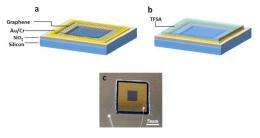Graphene-based Schottky junction solar cells: (a) undoped, (b) doped, and (c) an image of a doped solar cell showing contacts and contact leads. Image credit: Miao, et al. ©2012 American Chemical Society
(Phys.org) -- By taking advantage of graphene’s favorable electrical and optical properties, and then adding an organic dopant, researchers have achieved the highest power conversion efficiency yet for a graphene-based solar cell. The 1.9% power conversion efficiency of the undoped devices increases by more than four times to 8.6% after doping.
The researchers, led by Sefaattin Tongay and Arthur F. Hebard at the University of Florida in Gainesville, have published their study on the high-efficiency graphene solar cells in a recent issue of Nano Letters.
“Here, not only we have taken advantage of graphene's beautiful optical transparency, but also we have reduced graphene's electrical resistance by adjusting the Fermi level of graphene using a cheap and environmentally stable organic coating layer,” Tongay told Phys.org. “During this step, Nature favored us by yielding a higher rectification and electric field at the interface, further improving the solar cell’s efficiency.”
In the new solar cells, a single layer of graphene placed on top of a silicon wafer serves as a Schottky junction, the main component of simple photovoltaic devices called Schottky junction solar cells.
Under illumination, electron-hole pairs are photogenerated in the silicon. The photogenerated electrons and holes are separated by the Schottky junction’s built-in electric potential and collected by the oppositely charged graphene and semiconductor contacts. This one-way flow of current (electrons flowing in one direction and holes in the other) is a defining property of the Schottky junction and enables the generation of power from the device.
While graphene-based Schottky junction solar cells have been demonstrated in the past, here the researchers took an extra step and doped the graphene with the organic chemical TFSA using a simple spin-casting method.
Doping allowed the researchers to adjust graphene’s Fermi level (a measure of electron potential energy), which resulted in two changes that improved the solar cells’ overall efficiency: a reduction in the graphene’s resistance and an increase in the solar cell’s built-in potential, which leads to a more efficient separation of the electron-hole pairs generated by the absorbed photons.
With their 8.6% efficiency, the doped devices provide a significant efficiency improvement over other graphene-based Schottky junction solar cells, which have so far demonstrated power conversion efficiencies ranging from 0.1% to 2.86%.
Compared with Schottky junction solar cells that use indium tin oxide, those that use graphene have several advantages. For instance, the ability to tune graphene’s properties enables researchers to optimize solar cell efficiency and use the graphene layer on other semiconductors besides silicon.
The researchers hope that the methods used here, which are simple and scalable, can lead to further device improvements and practical applications in the future.
“We expect that the efficiency can be further improved by engineering the interface, using different organic coating layers yielding higher doping effects, improving the graphene quality and graphene transfer procedure, using anti-reflection layers, and numerous other methods known by the solar cell community,” Tongay said. “This is just a beginning.”
Hebard added that further discoveries of graphene physics should lead to more efficient and inexpensive solar cells.
“Our described power conversion efficiency increase with the simple application of a stable organic overlayer is just a beginning,” he said. “Graphene and its derivatives continue to surprise us with unusual properties (strength, flexibility, diffusion barrier, tunable Fermi energy, linear electronic spectrum, etc). Further advances will come with a deeper understanding of the physics of how incoming photons efficiently create electrons and holes, which are then separated and collected in our described configuration. This knowledge should be applicable to finding alternative substrates to silicon (organics and polymers come to mind), which are less expensive and can be applied to large areas.
“It's clear that research on graphene and its derivatives is already in the sunlight; we expect that our work on solar cells will keep it there.”
More information: Xiaochang Miao, et al. “High Efficiency Graphene Solar Cells by Chemical Doping.” Nano Letters. DOI: 10.1021/nl204414u
Journal information: Nano Letters
Copyright 2012 Phys.Org
All rights reserved. This material may not be published, broadcast, rewritten or redistributed in whole or part without the express written permission of PhysOrg.com.






















